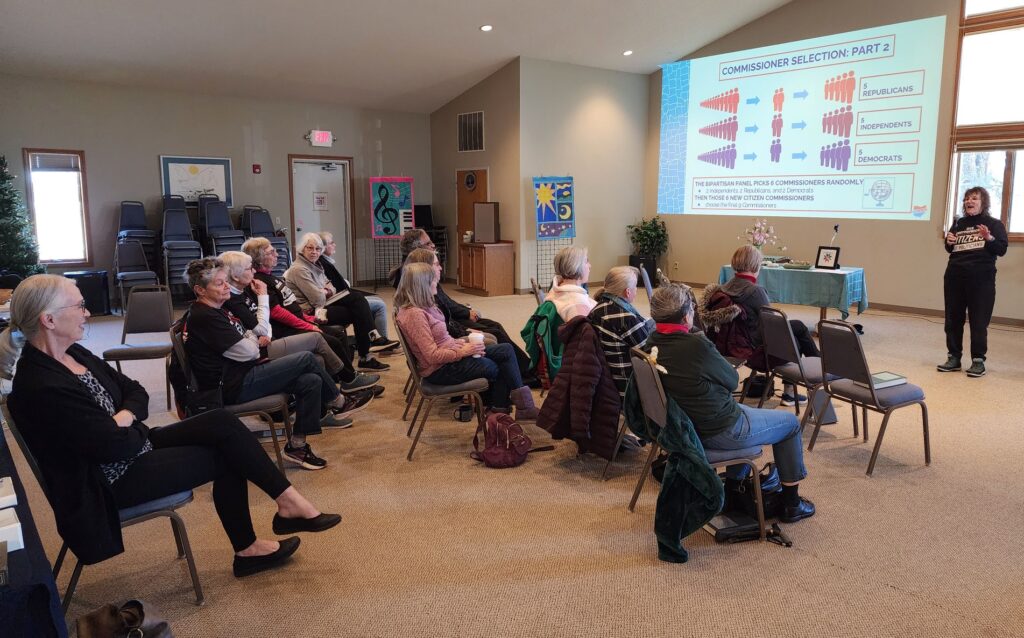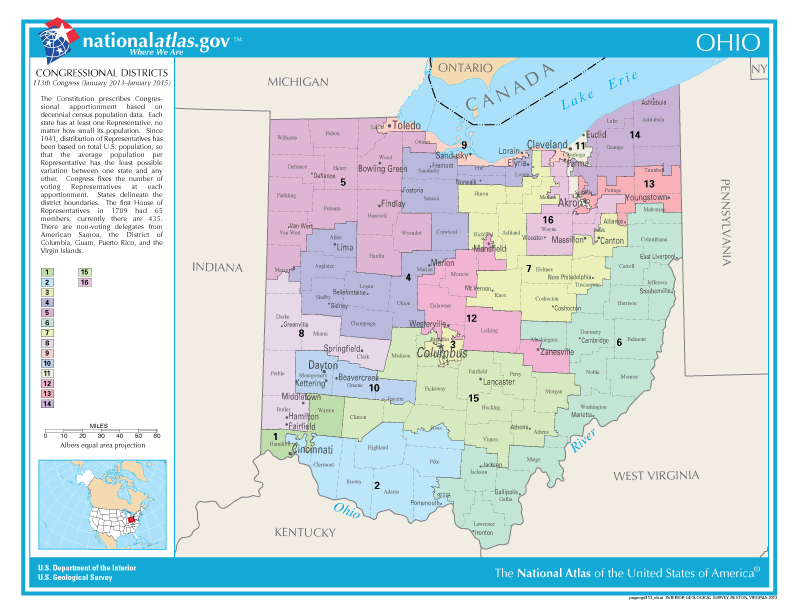By JAN McLAUGHLIN
BG Independent News
As Debbie Dalke collects signatures to end gerrymandering in Ohio, she is consistently met with the same question. “Didn’t we fix this already?”
The answer is a little complicated. Yes, Ohio voters have twice voted to require fair maps be drawn for the U.S. House of Representatives and the State Legislature. But no, the Republicans in Columbus stalled and spurned every effort to create fair districts and end gerrymandering.
The current maps, Dalke said Saturday as she spoke to a group of citizens, favor the party in power.
“The maps are drawn for job security,” she said.
Gerrymandering allows representatives to pick their voters – instead of voters picking who will represent them. Politicians become accountable to their base and political donors – no longer to their constituents, she said.
And while a bipartisan commission approved the current maps, both parties did not have an equal voice, Dalke said.
So this time around on the ballot, the Fair Districts Ohio group is trying a different strategy. The petitions are asking for a state constitutional amendment that takes power away from politicians.
If passed, the legislature and governor won’t have the power to draw the maps, or the authority to reject fair maps from being adopted.
“This is as good as we can get,” Dalke said.

To make it on November ballots in Ohio, approximately 420,000 signatures must be collected. Some counties are required to have signatures from at least 5% of the number of voters who cast ballots in the last gubernatorial election. In Wood County, that’s about 2,500 signatures.
The “Citizens Not Politicians Amendment” is a citizen initiative to end gerrymandering. It bans lobbyists and politicians from the redistricting process and instead establishes an Ohio Citizens Redistricting Commission, empowering citizens to draw fair districts using an open and transparent process.
The key is removing elected officials – representing both parties – from the process.
The commission would be responsible for adopting a redistricting plan for the Ohio General Assembly and new districts for the U.S. House of Representatives. The commission would draw maps with input from experts, such as demographers, not politicians, Dalke said.
Seven states have independent citizen commissions – Arizona, California, Colorado, Idaho, Michigan, Montana and Washington.
Ohio is known for its gerrymandered districts, like the “snake on the lake” and a duck shaped district – both created to guarantee more Republican legislators are elected or re-elected.
“We are one of the most gerrymandered states in the U.S.,” Dalke said.
The 135th Ohio General Assembly was elected in 2022 under Statehouse maps declared to be unconstitutional gerrymanders five times by a bipartisan Ohio Supreme Court majority.
Despite a constitutional mandate to draw districts reflecting voter preferences, the Republican politicians controlling five of seven seats on the Ohio Redistricting Commission ignored the court rulings, hired and then dismissed independent mapmakers and ran out the clock – resulting in voters again casting ballots in unconstitutional districts.
Under a system of gerrymander-rigged elections, only primaries matter. The results of the legislative general elections are nearly all foregone conclusions. The only challenge a lawmaker might face is getting primaried by someone willing to be more extreme, Dalke said.
Dalke said the petitions being circulated for the citizens commission are just to get the issue on the ballot.
“It will be up to all Ohio voters to decide if we want this,” she said.
If passed, the Ohio Citizens Redistricting Commission would be made up of five Republicans, five Democrats, and five independents. It bans lobbyists and politicians from the redistricting process.
The citizens commission would eliminate the Ohio Redistricting Commission, a seven-member panel made up of all elected officials, five from the GOP majority and two Democrats.
The average Ohio voter preferences in the last 10 election cycles shows a 56 to 43 Republican-to-Democratic split in voter preferences. But Dalke said because of gerrymandered districts, Republican lawmakers have a 67 to 32 supermajority in the Ohio House, controlling 68% of the seats, and a 26 to 7 supermajority in the Ohio Senate, controlling 78% of the seats.
The amendment calls for a redrawing process in 2025 to replace the current Congressional and State House maps. That means new maps for the 2026 elections. Maps would again be drawn after the new census data comes out in 2031, and then every decade following the census.

The redistricting hearings would be accessible and transparent, with the citizen commission being required to conduct hearings inviting broad public participation across the state.
Prior to the release of a draft redistricting plan, the commission would be required to hold at least five public hearings to gather public input from geographic regions of Ohio, including the northeast, southeast, northwest, southwest and central.
After release of a draft redistricting plan, the commission would then hold at least five additional public hearings across the five geographic regions to receive public comment on the proposed districts.
The legal dispute over redistricting has been going on for two years, with the Ohio Supreme Court rejecting two separate congressional maps and five sets of Statehouse maps — with districts for the Ohio House and Senate in Columbus still gerrymandered in favor of Republicans.
Despite the maps being deemed unconstitutional before the 2022 elections, they continue to be used due to Republicans essentially letting the clock run out after refusing the court’s order to write up new, fairer maps by the prescribed deadline.
In late September 2023 — 16 months after the court-imposed June 2022 deadline for passing a new set of maps — a new set of legislative maps were approved, which fair district advocates deemed “illegally gerrymandered” in favor of Republicans.
Those maps will again be used in this year’s elections.
More information on the current redistricting efforts can be found at https://www.fairdistrictsohio.org/.





